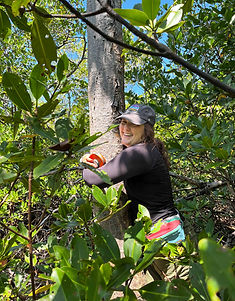top of page


Zoë Shribman
PhD student
zshribman(at)tulane.edu
Blue carbon science and management in Singapore and Mexico
My doctoral research aims to better understand how mangrove blue carbon stocks and fluxes vary across environmental and geomorphic settings, across scales and in multiple locations around the world. I am currently focused on a mangrove blue carbon project in Baja California Sur, Mexico, working with COSTASALVAJE and Las Guardianas del Conchalito to further understand mangrove carbon cycling of scrub forests in this region. I am investigating how scales matter when considering carbon stocks and fluxes for mangroves, and how localized environmental patterns and geomorphology may inform carbon distributions. I intend for this work to have a translational component, considering how this data may be used to inform on-the-ground mangrove restoration and conservation projects. This PhD work in Mexico is the culmination of my vision to develop technical expertise in coastal wetland ecosystem ecology and soil biogeochemistry while contributing to real-world natural climate solutions and promoting community-based efforts for mangrove reforestation and conservation.
I have been a mangrove enthusiast for over ten years! Before joining the Department of Earth & Environmental Sciences at Tulane University, I spent the first semester of my PhD at the National University of Singapore in the field, investigating how carbon stocks in mangrove forests vary along environmental gradients in Singapore. Previously I worked with Florida International University, investigating ecological impacts of Hurricane Irma on mangroves of the Rookery Bay National Estuarine Research Reserve. I received an M.S. in Oceanography & Coastal Sciences at Louisiana State University with Professor Robert Twilley, studying mangrove systems ecology, belowground carbon storage, and soil development in three diverse systems in Southwest Florida. As an undergraduate I studied marine science at Eckerd College, focused on Indonesian mangrove forest structure and floral biodiversity with Professor Jeannine Lessmann. While in Indonesia, I developed a working proficiency in Bahasa Indonesia that enhanced my coastal science fieldwork and international partnerships, and inspired my continued interest in learning languages. I collaborated with Mangrove Action Project in Thailand and Blue Forests in Indonesia, promoting community-based ecological mangrove restoration. Additionally, I participated in a commercial carbon peatland project with Forest Carbon in Jakarta, and learned about mangrove ecology and blue carbon policy at the University of Queensland as an occupational trainee with Professor Catherine Lovelock.
PUBLICATIONS
Friess, Shribman, Stankovic, Iram, Baustian, Lewis. 2024. Restoring blue carbon systems. Cambridge Prisms: Coastal Futures, 2:e9, 1-33. doi:10.1017/cft.2024.9.
Friess, Adams, Andradi-Brown, Bhargava, Carrasco, Dahdouh-Guebas, Heck, Herr, Kodikara, Michie, Shribman, Slobodian, Su, Taira, Uddin, Wodehouse. 2024. Mangrove forests: their status, threats, conservation and restoration. 6.17 in Treatise on Estuarine and Coastal Science. ISBN 9780323910422, https://doi.org/10.1016/B978-0-323-90798-9.00031-7.
Shribman 2021. Blue carbon in South Florida’s mangroves: the role of large roots and necromass. Master’s Thesis, Louisiana State University. https://digitalcommons.lsu.edu/gradschool_theses/5433/
Stewart-Sinclair, Purandare, Bayraktarov, Waltham, Reeves, Statton, Sinclair, Brown, Shribman, Lovelock. 2020. Blue restoration—building confidence and overcoming barriers. Frontiers in Marine Science 7, 748.
Chatellier, Shribman. 2018. Siné-Saloum Delta: An illustrated guide to Senegal’s remarkable mangrove estuary. E-book, self-published. https://tinyurl.com/applebooks-SineSaloumDelta
Shribman 2017. Mangrove diversity & forest structure in Nusa Lembongan, Bali, and Bangka Island, North Sulawesi, in Indonesia. Bachelor's Thesis, Eckerd College.



bottom of page